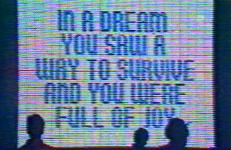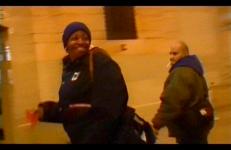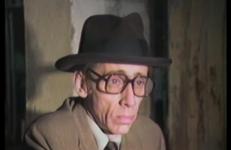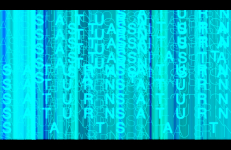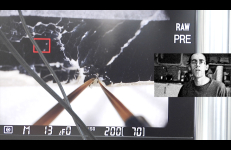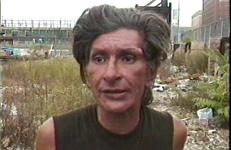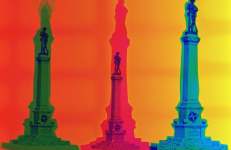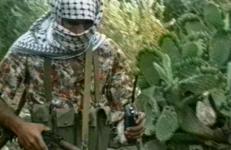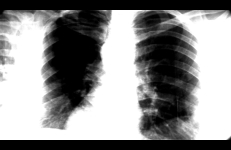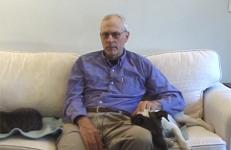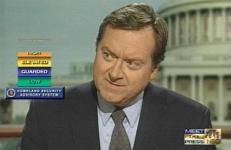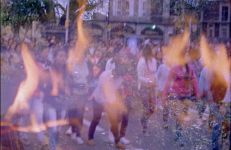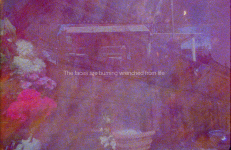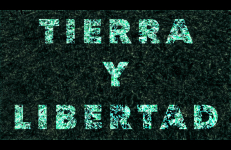On the eve of the 1984 Presidential election, Jenny Holzer used a truck equipped with a sound system and an 18-foot Diamond Vision electronic board to display images, statements, and man-on-the-street interviews. This tape presents a tightly edited version of the art, texts, and interviews that occurred throughout the day.
Activism
During my residency in New York I was designing a computer virus, which would contaminate computers through a screensaver that read “there is so much love in this world”. In the meanwhile, inspired by the illusionary democratic representation system in the United States and triggered by the indifference of the New York public to the presidential campaign, I went out to the streets to distribute fliers that carried this virus sentence. People of New York reacted in different ways to this action, which had similarities with many other hand-out actions common in big cities.
Sounds in the Distance is a video adaptation of David Wojnarowicz's 1982 book Sounds in the Distance: Thirty-five Monologues from the Road.
Cast in order of appearance: Allen Frame, Tara Kelly, Nan Goldin, Kirsten Bates, Elisabeth Walker, Bill Rice, Brian Burchill, Suzanne Fletcher, Frank Franca.
Directed by Kirsten Bates and Allen Frame, Produced by Peggy Bates
Stasi is an audiovisual recall of the political and social substrates that sustain an actual system of images. Stasi is a recall of a system of images that, even now, dominates the global gaze of the world.
The State of Things documents the melting away of Democracy in 2006 on the third anniversary of the Iraq War. The sculpture was installed at Jim Kempner Fine Art in New York City and disappeared over a period of 26 hours.
Voiceover: George W. Bush
Subsequently Ligorano Reese installed the sculpture at MCADenver and the Minnesota state capitol in St. Paul during the 2008 political conventions.
Ice Sculpture by Okamoto Studio
Originally commissioned by the Harvard Art Museums in response to the life and work of David Wojnarowicz, Survivor’s Remorse looks at how both art and bodies are maintained and the socio-economic influences that create a chasm between the value of things and people. This work examines the resources dedicated to the maintenance and care of artworks versus (artists) lives, especially those marginalized by illness or identity.
Sylvia is a portrait of the civil rights pioneer Sylvia Rivera for her memorial service in 2002, as told by her chosen family immediately following her death. "A veteran of the 1969 Stonewall uprising, Sylvia was a tireless advocate for all those who have been marginalized as the 'gay rights' movement has mainstreamed. Sylvia fought hard against the exclusion of transgender people from the Sexual Orientation Non-Discrimination Act in New York, and was a loud and persistant voice for the rights of people of color and low-income queers and trans people." --SRLP.org
Statement
A last stand for the silent guardians of the old order. Take It Down is a filmic day of reckoning for the Old Confederate South. What is up must come down, like the Confederate soldier monuments standing in court house squares across the South. At long last, a grand inversion! Solarized film makes positives bleed into negatives. The South is renewed.
This film looks to North Carolina to describe the cultural fissure that runs through the South, a legacy of the Civil War. In the context of the divisive Trump presidency and the increasing visibility of white supremacist activism, these Confederate memorials have become sites of conflicting politics and historical narratives.
Historians agree that a majority of Confederate statues were erected as propaganda tools legitimizing racism in the era of Jim Crow laws. For example, “Silent Sam”, a statue depicted in the film, was erected on the quad of the University of North Carolina campus. In an act of civil disobedience in Fall 2018, students and protestors tore down the statue in a statement against white supremacist oppression.
In Takeover of the Empire State Building, Brenda and Glennda visit the top of the Empire State Building as it is lit up in lavender for Gay Pride. They interview both tourists visiting the building, and activists who have come to see the lights. Ultimately, they question whether this gesture is adequate, or if there is still a way to go until equality is achieved.
An oblique, albeit powerful documentary that examines the current conditions, politics, and economics of South Lebanon. The tape focuses on the social, intellectual, and popular resistance to the Israeli occupation, as well as conceptions of "the land" and culture, and the imperiled identities of the Lebanese people. Simultaneously, the tape self-consciously engages in a critique of the documentary genre and its traditions.
An oblique, albeit powerful documentary that examines the current conditions, politics, and economics of South Lebanon. The tape focuses on the social, intellectual, and popular resistance to the Israeli occupation, as well as conceptions of "the land" and culture, and the imperiled identities of the Lebanese people. Simultaneously, the tape self-consciously engages in a critique of the documentary genre and its traditions.
This two-part episode features Glenn Belverio and Duncan Elliott participating in an ACT UP demonstration at President George Bush’s summer house in Kennebunkport, Maine, interviewing activists and documenting this historic event. In addition to this, Brenda Sexual and Glennda Orgasm attend Wigstock, an annual outdoor drag festival in Manhattan's East Village. At the festival, they rally for National Healthcare and discuss other issues such as violence against LGBTQ+ people.
This two-part episode features Glenn Belverio and Duncan Elliott participating in an ACT UP demonstration at President George Bush’s summer house in Kennebunkport, Maine, interviewing activists and documenting this historic event. In addition to this, Brenda Sexual and Glennda Orgasm attend Wigstock, an annual outdoor drag festival in Manhattan's East Village. At the festival, they rally for National Healthcare and discuss other issues such as violence against LGBTQ+ people.
Parry Teasdale is one of the founding members of the video art collective Videofreex, which was active in the 1960s and 70s. In this extensive two-part interview Teasdale explores the collective’s motivations and endeavors, which embodied the social and political concerns of the period.
In this video, Brenda and Glennda attend the opening day of The New Festival (now known as NewFest), a queer film festival in New York City. They interview attendees and filmmakers at the festival to discuss the importance of queer film. Videographer Hans Christian Dany pans back and forth between Brenda and Glennda's interviews and onlookers of the festival, some of whom seem intrigued by the crowd gathering outside the theater, and some who seem offended by the openly queer festival goers.
In this episode of The Glennda and Brenda Show, Glennda and Brenda take over a public bus to protest discrimination and violence against queer people who are "out and outrageous". They pick up many other out and proud friends to stage this queer sit-in.
Interspersed with clips of Judy Garland films and televised concerts, Glennda Orgasm and Judy LaBruce (Bruce LaBruce's Garland inspired drag persona) travel to the West Village to "discover their gay roots". They discuss the current state of queer culture with people attending gay bars and patroning queer businesses, with a cameo from Sadie Benning. They discuss the idea of the post-queer movement, and give guests a "post-queer quiz".
An episode of Glennda and Friends, hosted by Glennda Orgasm and Judy LaBruce.
The Sun Quartet is a solar composition in four movements, a political composition in four natural elements, an audiovisual composition in four bodily mutations: a sun stone where youth blooms in protest, a river overflowing the streets, the burning plain rising in the city. And, finally, the clamor of the people that shook Mexico after the night of September 26, 2014. The disappearance of 43 students from Ayotzinapa opened a breach in the Mexican political body.
The Sun Quartet is a solar composition in four movements, a political composition in four natural elements, an audiovisual composition in four bodily mutations: a sun stone where youth blooms in protest, a river overflowing the streets, the burning plain rising in the city. And, finally, the clamor of the people that shook Mexico after the night of September 26, 2014. The disappearance of 43 students from Ayotzinapa opened a breach in the Mexican political body.
The Sun Quartet is a solar composition in four movements, a political composition in four natural elements, an audiovisual composition in four bodily mutations: a sun stone where youth blooms in protest, a river overflowing the streets, the burning plain rising in the city. And, finally, the clamor of the people that shook Mexico after the night of September 26, 2014. The disappearance of 43 students from Ayotzinapa opened a breach in the Mexican political body.
The Sun Quartet is a solar composition in four movements, a political composition in four natural elements, an audiovisual composition in four bodily mutations: a sun stone where youth blooms in protest, a river overflowing the streets, the burning plain rising in the city. And, finally, the clamor of the people that shook Mexico after the night of September 26, 2014. The disappearance of 43 students from Ayotzinapa opened a breach in the Mexican political body.
In 2011 as the Congress debated the budget, Ligorano Reese installed an ice sculpture of the words Middle Class in the garden of Jim Kempner Fine Art. They filmed this timelapse of the sculpture disappearing using Senator Bernie Sanders' filibuster against the Bush tax cuts as a soundtrack with music by Michael Galasso. Senator Sanders featured it on his Senate homepage.
Ice Sculpture by Okamoto Studio.
This is an agitprop piece about the reflection and dispersion of an eroded slogan and claim: Tierra y Libertad (Land and Freedom).




